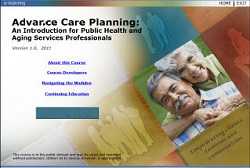Information for Consumers and Professionals
Changing Demographics Bring New Challenges and Opportunities
Successful public health strategies and medical advancements have contributed to extraordinary gains in life expectancy in the United States. Someone born in 1900 could expect to live an average of 47 years. A baby born today may well live to see his or her 80th birthday.

This gain of more than 30 years of life has widespread public health implications. Today, Americans are much more likely to die at a later age and most often from a chronic disease. Many Americans wish to die at home, with family present, and without pain. However, the experience of death for many Americans is quite different than what they would want.
If you are a professional in the public health or aging services networks, you are in a unique position to help older Americans and their families better understand the role of advance care planning.prof Those you serve may have already turned to you with questions about completing an advance directive, designating a health care proxy, the role of hospice and palliative care, and other related issues.

To provide you with information and key resources on advance care planning, CDC worked closely with The Center for Practical Bioethics and the Directors of Health Promotion and Education to develop a new, online course designed specifically for public health and aging services professionals.
The self-paced course modules cover basic information about advance care planning, offer opportunities to apply gained knowledge, and provide access to relevant tools and resources. This interactive course is free on CDC’s Website and participants can earn selected continuing education credits.
Advance Care Planning as Part of the Public Health Agenda
Advance care planning is increasingly being viewed as a public health issue, given its potential to prevent unnecessary suffering and support an individual’s health care decisions and preferences. In recent years, CDC has taken steps to frame advance care planning as part of the public health agenda.
Framing End of Life As a Public Health Issue
In 2002, CDC first framed the end of life as a public health issue in the article “End of Life as a Public Health Issue” published in the American Journal of Preventive Medicine.
Just as promoting health and quality of life is a major public health focus, so too should be helping to ensure that the time leading to the end of life is in keeping with the individual’s wishes and as pain-free as possible. A public health focus on death with dignity and with one’s wishes honored is the logical extension of public health’s efforts to promote well-lived, healthful lives. Advance care planning can help make that goal a reality.
As the number of older Americans continues to grow, the proportion with mild cognitive impairment is expected to increase substantially, raising important questions about when an individual has sufficient cognitive abilities to make their own health care decisions. CDC has examined the association between cognitive functioning and completing an advance directive, or durable power of attorney for health care. Read Completion of a Durable Power of Attorney for Health Care: What Does Cognition Have to Do With It? for more information.
CDC also has introduced a new approach to identify potential public health surveillance-related items for to end-of-life issues. On the basis of an environmental scan of existing end-of-life surveys, relevant topics were identified that have already been incorporated into public health surveillance as well as topics that have not been examined and public health surveillance should be conducted.
Identifying End-of-Life Public Health Priorities
Working closely with the National Association of Chronic Disease Directors, CDC consulted more than 200 key stakeholders to identify public health priorities related to the end of life and initiated work to address these priorities.
The top priorities include the following:
- Identify a chronic disease point person within the state health department to coordinate or be the liaison for end-of-life activities with relevant issues (e.g., aging and cancer).
- Collect, analyze, and share end-of-life data through state surveys such as CDC’s Behavioral Risk Factor Surveillance System (BRFSS).
- Incorporate end-of-life care into state comprehensive cancer control plans.
- Educate the public about hospice and palliative care availability.
- Educate the public about the importance of advance directives and health care proxies.
Learn more about the priorities and the process used to develop end-of-life initiatives Social Research methods [PDF–156KB] and “The Role of State Health Departments in Addressing End-of-Life Issues [PDF–138KB]” .
Developing A New, Online Course Specifically Tailored to Public Health and Aging Services Professionals
Professionals in the public health and aging services networks work closely with those they serve and are in a unique position to help educate the public on advance care planning and related issues such as hospice and palliative care. While most Americans have heard of a “living will,” many do not understand their options and opportunities about advance care planning and only 30% have completed an advance directive.
To equip and educate these professionals with useful knowledge to talk to their clients about advance directives and answer their questions, CDC, in cooperation with the Center for Practical Bioethics and the Directors of Health Promotion and Education, has developed new, free online course specifically designed for public health and aging professionals.
Assessing How State Comprehensive Cancer Plans Address End-of-Life Issues
To establish a baseline for how many comprehensive cancer control plans included a reference to end-of-life, CDC examined 45 state plans in 2007, looking at keywords, definitions, topics, data, goals, and strategies. Of the 45 plans (all developed by January 31, 2006), 41 (or 91%) included the keyword end of life. Every plan had an identified keyword related to end of life, 98% included at least 1 end-of-life topic, and more than 50% included material on end of life in 5 or more topic areas.
In the plans, goals for the end of life were most often characterized as use of care, access to care, and awareness of end-of-life-related issues among patients, the public, and providers. The leading end-of-life strategies identified were research, provider education, and patient and public education.
The findings of this study not only provided valuable baseline information, but were encouraging because most states had addressed the end-of-life topic to some extent in their comprehensive cancer control plans. Learn more about the Comprehensive Cancer Control Plans: A Content Review [PDF–1.7MB] study.
- Page last reviewed: August 20, 2012
- Page last updated: August 20, 2012
- Content source:


 ShareCompartir
ShareCompartir